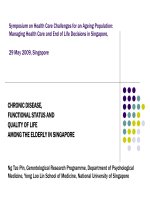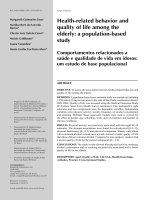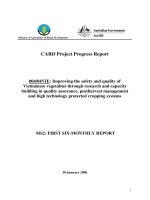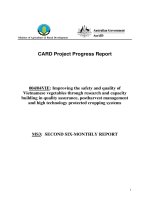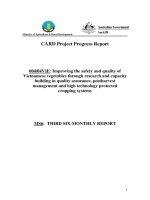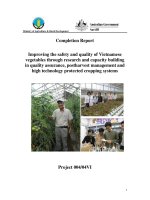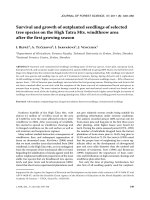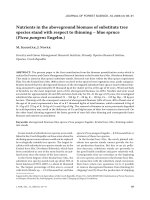The growth and quality of indigenous tree species planted under the forest canopy in thach thanh district thanh hoa province
Bạn đang xem bản rút gọn của tài liệu. Xem và tải ngay bản đầy đủ của tài liệu tại đây (1.06 MB, 79 trang )
MINISTRY OF AGRICULTURE AND RURAL DEVELOPMENT
VIETNAM NATIONAL UNIVERSITY OF FORESTRY
STUDENT THESIS
THE GROWTH AND QUALITY OF INDIGENOUS TREE SPECIES
PLANTED UNDER THE FOREST CANOPY IN THACH THANH
DISTRICT, THANH HOA PROVINCE
Major: Natural Resources Management
Faculty: Forest Resources and Environmental Management
Student: Nguyen Ngoc Khanh
Student ID: 135 309 1001
Class: K59B - Natural Resources Management
Course: 2014 - 2019
Advanced Education Program
Developed in collaboration with Colorado State University, USA
Supervisor: Assoc.Prof. Dr. Pham Minh Toai
Ha Noi, October/2018
CONTENTS
LIST OF TABLES
LIST OF FIGURES
LIST OF ABBREVIATIONS
ACKNOWLEDGEMENT
ABSTRACT
INTRODUCTION ................................................................................................................. 1
CHAPTER 1: OVERVIEW OF RESEARCH ....................................................................... 2
1.1. In the world ..................................................................................................................... 2
1.1.1. Research on mixed plantations .................................................................................... 2
1.1.2. Research on indigenous trees planting under forest canopy ........................................ 3
1.2. In Viet nam ..................................................................................................................... 4
1.2.1. Research on mixed plantations .................................................................................... 4
1.2.2. Research on indigenous trees planting under forest canopy ........................................ 6
1.3. Techniques for planting indigenous forests under the forest canopy of the project ....... 9
1.3.1. History of forest plantation in the research area .......................................................... 9
1.3.2. Techniques for planting Acacia auriculiformis forests of the project ....................... 10
1.3.3. Technique for planting indigenous forest under forest canopy ................................. 10
1.3.3.1. Technical procedures for planting Erythrophleum fordii based on the project
regulations (2011) ................................................................................................................ 10
1.3.3.2. Technical procedures for planting Hopea odorata based on the project regulations
(2011) ................................................................................................................................... 11
CHAPTER 2: OBJECTIVES, CONTENTS AND RESEARCH METHODS .................... 12
2.1. Objectives of the research ............................................................................................. 12
2.2. Subjects and research methods ..................................................................................... 12
2.2.1. Research methodology on standard plot .................................................................... 12
2.2.2. Research on the physical characteristics of soil in the research area ......................... 12
2.2.3. Research on the structure of forest ............................................................................ 13
2.2.4. Methods of data processing ....................................................................................... 14
CHAPTER 3: NATURAL CONDITIONS OF RESEARCH AREA .................................. 16
3.1. Geographical location ................................................................................................... 16
3.2. Topographic .................................................................................................................. 16
3.3. Hydrological conditions ................................................................................................ 17
3.4. Soil ................................................................................................................................ 17
3.5. Water resources............................................................................................................. 18
3.6. Forest resources ............................................................................................................ 18
CHAPTER 4: RESULTS AND DISCUSSION................................................................... 19
4.1. Growth characteristics and quality of indigenous trees under forest canopy in the study
area ....................................................................................................................................... 19
4.1.1. Growth characteristics and quality of Erythrophleum fordii ..................................... 19
4.1.1.1. Growth characteristics of Erythrophleum fordii ..................................................... 19
4.1.1.2. The quality of growth of Erythrophleum fordii ...................................................... 22
4.1.2. Growth characteristics and quality of Hopea odorata ................................................ 23
4.1.2.1. Growth characteristics of Hopea odorata................................................................ 23
4.1.2.2. The growth quality of Hopea odorata ..................................................................... 27
4.2. Evaluate the factors affecting the growth of indigenous plants .................................... 28
4.2.1. Factors affecting the growth of Erythrophleum fordii ............................................... 28
4.2.1.1. The structure and growth of tall plant of Acacia auriculiformis............................. 28
4.2.1.2. Characteristics of soil under forest canopy ............................................................. 30
4.2.2. Factors that affect the growth of Hopea odorata........................................................ 31
4.2.2.1. The structure and tall plant growth of Acacia auriculiformis ................................. 31
4.2.2.2. Characteristics of soil under forest canopy ............................................................. 32
4.3. Proposing some silvicultural techniques to promote the growth of indigenous trees in
the research area................................................................................................................... 33
4.3.1. Impact solution in Erythrophleum fordii forest ......................................................... 34
4.3.2. Impact solution in the Hopea odorata forest .............................................................. 34
CHAPTER 5: CONCLUSION, CONSTRAINTS AND RECOMMENDATIONS ........... 35
5.1. Conclusion .................................................................................................................... 35
5.2 Constraints ..................................................................................................................... 35
5.3. Recommendations ......................................................................................................... 36
REFERENCES
APPENDIX
LIST OF TABLES
Table 2.1: Forest land profile analyzing results ................................................................... 12
Table 2.2: Growth characteristics of Acacia auriculiformis ................................................ 13
Table 2.3: Growth Characteristics of indigenous trees ........................................................ 14
Table 4.1: Growth Characteristics of Erythrophleum fordii (7 years) ................................. 19
Table 4.2: Comparison of the difference in diameter at breast height (D1.3) of
Erythrophleum fordii between standard plots (U standard)................................................. 19
Table 4.3: Comparison of the difference in the total height (Ht) of Erythrophleum fordii
between standard plots (U standard) .................................................................................... 20
Table 4.4: Comparison of the difference in diameter of the canopy (Dc) of Erythrophleum
fordii between standard plots (U standard) .......................................................................... 21
Table 4.5: Percentage of good, medium and bad trees of Erythrophleum fordii forest ....... 22
Table 4.6: Growth Characteristics of Hopea odorata (7 years) ........................................... 23
Table 4.7: Comparison of the difference in diameter at breast height (D1.3) of Hopea
odorata between standard plots (U standard) ....................................................................... 23
Table 4.8: Comparison of the difference in the total height (Ht) of Hopea odorata between
standard plots (U standard) .................................................................................................. 24
Table 4.9: Comparison of the difference in diameter of the canopy (Dc) of Erythrophleum
fordii between standard plots (U standard) .......................................................................... 25
Table 4.10: Percentage of good, medium and bad trees of Hopea odorata forests are
summarized in the table: ...................................................................................................... 28
Table 4.12: Distribution of growth quality of Acacia auriculiformis forest (Erythrophleum
fordii under canopy)............................................................................................................. 29
Table 4.13: Erythrophleum fordii forest land profile analyzing results .............................. 30
Table 4.14: Growth characteristics of Acacia auriculiformis (Hopea odorata under canopy)
(11 years) ............................................................................................................................. 31
Table 4.15: Distribution of growth quality of Acacia auriculiformis forest (Hopea odorata
under canopy) ...................................................................................................................... 32
Table 4.16: Hopea odorata forest land profile analyzing results ......................................... 33
LIST OF FIGURES
Figure 4.1: Comparison of diameter at breast height (D1.3) of Erythrophleum fordii under
canopy of Acacia auriculiformis .......................................................................................... 20
Figure 4.2: Comparison of the total height (Ht) of Erythrophleum fordii under canopy of
Acacia auriculiformis ........................................................................................................... 21
Figure 4.3: Comparison of diameter of the canopy (Dc) of Erythrophleum fordii under
canopy of Acacia auriculiformis .......................................................................................... 22
Figure 4.4: Comparison of diameter at breast height (D1.3) of Hopea odorata under canopy
of Acacia auriculiformis ...................................................................................................... 24
Figure 4.5: Comparison of the total height (Ht) of Hopea odorata under canopy of Acacia
auriculiformis ....................................................................................................................... 25
Figure 4.6: Comparison of diameter of the canopy (Dc) of Erythrophleum fordii under
canopy of Acacia auriculiformis .......................................................................................... 27
Picture 4.2: Soil profile in Hopea odorata area .................................................................... 33
LIST OF ABBREVIATIONS
SP
Standard plot
D1.3
Diameter at breast height (m)
HT
The total height (m)
HUC
The height under canopy (m)
DC
Diameter of the canopy (m)
̅ 1.3
The average of diameter at breast height (m)
̅t
The average of total height (m)
̅c
The average of diameter of the canopy (m)
CC
Canopy cover
JICA
Japan International Cooperation Agency
KfW
German Reconstruction Banks
ACKNOWLEDGEMENT
This thesis was completed at the Vietnam National University of Forestry,
following the undergraduate training programs in the period of 2014-2019 with the natural
resources management major (Advanced Education Program). This major was developed
in collaboration with Colorado State University, USA. During the implementation and
completion of the thesis, the author has received the support from School-Board of
University, Faculty of Silviculture, Faculty of Forestry and Environmental Management
that was precious and effective.
The author expresses the sincere and deepest gratitude to Assoc. Prof. Dr. Pham
Minh Toai as an instructor who has paid attention to the thesis, spent a lot of time for
instruction and provided many relevant valuable materials. These have helped the author to
complete this thesis.
The author would like to thank the leaders and officers of the Management Board
for Forestry Projects to facilitate the study and completion of the thesis.
Finally, the author would like to express sincere gratitude to friends, classmates,
and supporters during the studying years as well as the completion of this thesis.
Sincerely thanks!
Hanoi, October 30th, 2018
Student
Nguyen Ngoc Khanh
ABSTRACT
The purpose of this research is studying on growth characteristics and quality of
indigenous tree species planted under the canopy of Acacia auriculiformis plantations. The
thesis has clarified the stand’s structure and quality of indigenous tree species,
characteristics of soil under the forest canopy and the effects of tall trees to indigenous
trees, then has provided silvicultural solutions. The research will help to improve the
growth of indigenous trees in the next years.
INTRODUCTION
In recent years, the trend to develop indigenous tree species has become stronger and
can achieve many objectives in terms of economic, social and environmental aspects.
However, the indigenous plantation programs/projects have still faced many difficulties due
to the lack of support from managers, investors and forest owners.
The afforestation project implemented in Thanh Hoa and Nghe An provinces (KfW4)
is one of the forestry programs focusing on the development of indigenous tree species,
mainly such as Erythrophleum fordii, Peltophorum pterocarpum, Hopea odorata,
Mylopharyngodon piceus, Michelia mediocris Dandy, etc with the target of developing
19,000 ha of sustainable production forest for over 14,000 households in 53 communes of 10
mountainous districts of two project provinces.
The development of indigenous tree species is carried out with two forest types: 1)
Planting pure indigenous trees; 2) Planting indigenous trees under the Acacia auriculiformis
canopy. The area of 3,000 ha of planted pure indigenous tree species (mainly Aquilaria
crassna, Chukrasia tabularis, etc.) has become forest and has been initially evaluated to be
well-grown. While the area of about 300 ha of indigenous tree species has been planted under
the forest canopy such as Erythrophleum fordii, Peltophorum pterocarpum, Hopea odorata as
a pilot in Thach Thanh, Cam Thuy and Vinh Loc districts (Thanh Hoa province) and in
Quynh Luu and Yen Thanh districts (Nghe An province).
Within the scope of KfW4 plantation area, factors such as site conditions, seedlings,
and climatic conditions are almost identical but canopy cover is the most important factor
affecting the growth of indigenous tree species planted under the forest canopy. Generally,
most indigenous species are well-grown in shade-tolerant conditions at an early age, but their
light needs will change over time.
Therefore, the assessment of affect of canopy cover during each specific development
stage of indigenous trees is practical as a basis for proposing appropriate measures to promote
the growth of indigenous tree species under forest canopy. With the above reason, the project
on "The growth and quality of indigenous tree species planted under the forest canopy in
Thach Thanh district, Thanh Hoa province" is necessary, contributing to construction of
theoretical and practical basis to develop the indigenous plantations in the coming project
phases.
1
CHAPTER 1: LITERATURE REVIEWS
1.1. In the world
1.1.1. Research on mixed plantations
Researches in many countries around the world show that pure plantations have shown
many disadvantages. Therefore, scientists in the world have been interested in studying the
development of mixed forest models for sustainable forest business, especially in the current
phase of climate change.
In Malaysia (1999) [19], the multi-layered forestation project has introduced a model
of mixed plantation on three species: natural forest, 10-15 year Acacia plantation and 2 - 3
year Acacia plantation. The project uses 23 valuable indigenous species by planting strips in
natural forest, each strip includes three rows of indigenous trees. Total of 14 indigenous
species planted under the Acacia mangium canopy is divided into two experimental blocks:
Block A: Open the10m strip, plant 3 rows of indigenous trees.
Open the 20m strip, plant 7 rows of indigenous trees.
Open the 40m strip, plant 15 rows of indigenous trees.
Block B: Cut a row of acacia, plant a row of indigenous trees.
Cut 2 rows, plant 2 rows of indigenous trees.
Cut 4 rows, plant 4 rows of indigenous trees.
The results show that three species among 14 species of Block A have the fastest treeheight growth and the best diameter growth, including Shorea roxburrghii, Shorea ovalis and
Shorea leprosula. The tree-height growth of indigenous tree species planted in the 10m and
40m strips is better than those planted in the 20m strip. The best tree-height growth is shown
in the formula of mixed planting of one Acacia row and one indigenous row. From this
studying result, some recommendations to adjust the growth of experimental models at eight
times of 2-8-12-18-28-34-41-47 years after planting are given. This is one of research projects
on the of mixed-species forest establishment that is relatively complete in terms of technical
measures, from the selection of tree species to study of planting method, timing of planting
and model adjustment following the growing process for a long time. Therefore, these pilot
models will have many promising successes in future and can be replicated in practice.
The outstanding feature of mixed plantations is the multi-layered canopy. Therefore,
many global scientists have been interested in the establishment of multi-layered plantations.
During the study of canopy structure of mixed stands, Bernard Dupuy (1995) [20] has shown
that the canopy structure of mixed plantations depends on the growth and solidarity of tree
species in stands. This shows that the mixed plantation models having reasonable structure
and taking full advantage of nutrient space in maximum are only established once we base on
2
ecological characteristics as well as pay attention to interrelationships between tree species to
select the appropriate tree species. These are important bases to determine the success or
failure of mixed plantation models.
1.1.2. Research on planting indigenous tree species under the forest canopy
In recent years, the indigenous tree species have been studied, experimentally and
successfully planted in many places over the world. Of which, many trees belonging to
Paulownia genus have been paid attention by many regional and global countries. According
to Tran Quang Viet (2001) [1], from the 1960s in China, along with the forestation movement
and construction of protection forest belts, the Paulownia tree species were further researched
and developed by the Chinese Academy of Forestry (CAF); CAF has conducted a systematic
study of classification, ecological characteristics, distribution, planting techniques and
utilization of Paulownia tree species.
Basically, some other studies - such as planting on the strip and underplanting in
African and Asian countries - are also to establish the mixed forest stands on the basis of
existing tree species. In the areas where the Important Value of economically valuable tree
species is low, the forest quality can be improved by increasing the quantity of tree species
and quantity of individuals of economically valuable species through enrichment planting, for
examples: planting in Nigeria, Congo, Cameroon, etc. These studies have achieved many
good results through taking advantage of natural cover which has supported the main crops at
the early stages. The Potential Crop Trees (PCTs) for supplementary planting still live in the
moist forest. On the other hand, when the plants grow up, the opening of canopy of upper tree
species has been adjusted in time. The removal of vines and shrubs was also carried out
regularly, so the PCTs for supplementary planting were well-grown, forming high-yielding
mixed forest stands. This is an important lesson in selection of supporting trees for the
research project on technical measures of mixed forest of broad-leaved species.
In order to effectively manage the forest, each species needs to have its own density
and thinning for growing and developing. E.Assman (1961) [21], after reviewing 9 thinning
models with 4 tree species, indicated that thinning could not increase total timber output of
forest stands. However, with the Picea forest stands, intensively thinning will increase the tree
volume to 15-20% compared to trees without thinning. In comparison with the tree diameter
growth in the Tectona grandis forest stand at the age of 26 which was intensively thinned at
age 14. Iyppu and Chandrasekharan (1961) [23], it was found that the tree diameter in the
stands with intensively thinning was 39.9 cm while the diameter in the stands without
thinning was 29.5 cm. In general, the authors conclude that when the density of forest stands
decreases, the growth of individual trees, especially the diameter growth will increase sharply
3
while the total growth of forest stand will decrease, not increase or increase very little. The
increase in total yield by thinning is only due to the amount of products removed from
thinning.
The effect of planting density on the canopy development is quite obvious. The study
of Pinus patula, Julians Evan [18] shown that in the 19-year-old forest without thinning, the
length of canopy was only 29% of total length of the trunk; while at this age, in the forest that
was thinned once at the age 9, the canopy length was up to 40% of stem length. For canopy
area, Hunt (1969) [24] compared the effect of thinning to the 22-year-old forest stand of Pinus
strobus and concluded that after 5 years of thinning, total leaf weight of the forest after
thinning was 3 times higher than total leaf weight of forest stand without thinning.
Research the differences in sparse of trees in forest stand with different densities. Van
laar (1976) [25], showed that with Pinus planted in South Africa, in the stands with high
density (3000 trees/ha) the tree value was 0.565; whereas in the stands with low density (125
trees/ha), the same numerical value was only 0.495.
The above research shows that there is a real relationship between the morphological
parameters/ quality of forest trees and the densities. These are important conclusions not only
on theoretical implications but also on silvicultural significance. However, the above results
are only qualitative or quantitative comparisons. Therefore, the research on finding
relationships modeled mathematically between ecological factors, tree quality and density is
very necessary, in which the density can be expressed in many other ways.
1.2. In Viet Nam
1.2.1. Research on mixed plantations
Nguyen Ba Chat (1995) [17], when researching the forest restoration in Song Hieu
(1981 - 1985), experimented with planting Chukrasia tabularis mixed with other indigenous
species such as Peltophorum pterocarpum, Michelia mediocris Dandy, Gmelina arborea Roxb,
etc. to create a reasonable structure. After 10 years, the results showed that the mixed planting
of Chukrasia tabularis is better than the pure planting of Chukrasia tabularis. Mixed forest
using natural vegetation has better advantages on growth of tree species and has shown signs
of better soil recovery.
Tran Ngu Phuong (2000) [3] has also studied on establishing the mixed plantation
models to create multi-layer forest canopy for protection and production through the variously
mixed plantations such as mixture of tall trees and shrubs, mixture of tall trees and tall trees.
Based on the studying results of main laws of natural forest in northern Vietnam, the author
has shown that forest vegetation in our country is divided into many layers, from 2-3 timber
tree layers, not including the medium tree layer and fresh vegetation. Based on this principle,
4
the author has proposed a model of afforestation to meet the objectives of watershed
protection in key areas, of which two outstanding models of mixed afforestation are a mixed
model of permanent multi-layer production forest and a mixed model of temporary secondary
multi-layer production forests.
Pham Xuan Hoan (2004) [5] experimented on mixed plantation at Vietnam university,
planted 165 indigenous species under the canopy of Pinaceae and Acacia, of which 27
indigenous species planted under the Pinus massoniana canopy, 21 indigenous species
planted under the Acacia auriculiformis canopy, the remaining planted under the mixed forest
canopy between Pinus massoniana and Acacia auriculiformis, Pinus massoniana and Acacia
mangium, Eucalyptus, etc. The survival rate of indigenous species under the Pine canopy and
under the Acacia canopy was estimated to respectively reach 93.2% and 91.2%. The regular
growth and average growth of indigenous species vary widely among species. Especially,
some species - which have been often evaluated to have slow growth such as Cinnamomum
parthenoxylon, Erythrophleum fordii, etc. but have good shade tolerance at the early stages
under the Pine and Acacia canopies - were well-growth and very promising.
National Program 327 (a program of greening barren hills was implemented from
1993 to 1998) and the 661 projects (5 million hectares of newly planted forests, inherited
from Program 327) have also established many mixed plantations with indigenous broadleaf
species, mainly established protection forests in the key areas nationwide. Most of these
models use the supporting species such as Acacia mangium, Acacia auriculiformis, Senna
siamea with the mixed rate of 600 indigenous trees and 1000 supporting trees/ha. However,
the adjustment of canopy of supporting species in the mixed forest models has not been paid
attention and adjusted in time, so the main species have the very low survival rate and often
grow poorly. This is also a common weakness of most models in Project 327 and 661.
In addition to the research on establishment of mixed plantations by broadleaf species,
there are several research projects that create the mixed plantations between coniferous
species and broadleaf species, among imported species. Phung Ngoc Lan (1986) [7] studied
the experiment of creating the mixed forests in Luot Mountain - Vietnam National University
of Forestry - Xuan Mai, Pinus massoniana is selected as the main species. The author studied
the mixed plantation of Pinus massoniana, Acacia auriculiformis and Eucalyptus
camaldulensis in the different proportions, density, method and timing. Based on the criteria
of growth, soil and diseases, the authors made the following remarks:
+ After 2 years of growth, the mixed plantation of Pinus massoniana was better than
the pure plantation of Pinus massoniana. The mixed ratio has no significant effect on the
growth of Pinus on the test formulas.
5
+ In the mixed plantation formulas that were conducted, the earthworm efficiency was
more developed than the pure plantation formulas. This suggested that the soil properties were
improved significantly in the mixed plantations.
After 2 years, the authors found that the height growth of pure Pinus plantation was
2.53 m, while the height of Pinus mixed Acacia plantations with the ratio 1: 1 and the scale
1:2 respectively was 2.8 m and 2.72. m. The diameter growth of Pinus mixed Acacia
plantations with the ratio 2: 1 ratio was also greater and faster. In the mixed plantation of
Pinus massoniana and Eucalyptus camaldulensis, the Pinus growth was unknown.
1.2.2. Research on planting the indigenous trees under the forest canopy
In our country, the selection of indigenous species having advantages such as rapid
growth, good protection ability has a practical significance and scientific basis. In the recent
years, there have been many authors researching the conservation and development of some
indigenous species in Vietnam.
Trieu Van Hung (1993), [6], studied the "Biological characteristics of some forest
enrichment plants (Canarium album, Peltophorum pterocarpum). According to his comment,
in the Important Value of natural forest, Canarium album achieved only 3.87% an average
quantity of trees and 6.84% of standard plots. The ratio of Canarium album in the forest status
of IIIA1 was higher than in the forest status of IIIA2. In the forest, Canarium album species
often mixed with some other species such as Machilus bonii Lecomte, Peltophorum
pterocarpum, Choerospondias axillaris. etc.
Nguyen Hoang Nghia (1997) [9] introduced basic paradoxes of indigenous species,
which highlighted the difficulties in planting the indigenous tree species in our country.
Phung Ngoc Lan (1994) [8], after studying the characteristics of Erythrophleum fordii,
confirmed: The distribution of Erythrophleum fordii was very large and could be found in
most of the northern provinces of Vietnam (from Hai Van onwards) with the altitude of 900m
or less in the south and 500 m or less in the north; developed in low mountains, slopes less
than 20 degrees or in the foothills.
Pham Xuan Hoan (2002) [4], from the study "Characteristics of some circumstantial
factors of experimental mixed plantations of tropical broadleaf trees at Ecological Restoration
Zone of Cat Ba National Park" and "Experimental research - planting indigenous trees under
the canopy of Pinus massoniana and Acacia auriculiformis in the experimental forest of
Vietnam National University of Forestry". The authors provided some results such as the
good growth of some indigenous species planted under forest canopy, especially under the
canopy of Acacia auriculiformis and Pinus massoniana; and also identified some major
6
factors affecting the growth of indigenous species such as canopy cover of upper layers, light
intensity, soil.
According to Vi Hong Khanh (2003) [12], when assessing the growth of some
indigenous species for forest conservation and development in Cau Hai - Phu Tho province,
concluded that most Erythrophleum fordii had high survival rates and good growth; at the
same time, out of 34 indigenous species, the study site selected the following tree species for
growth assessment: Cinnamomum bejolghota, Canarium album, Peltophorum pterocarpum,
Erythrophleum fordii, Prunus arborea, Michelia mediocris Dandy which were fast-growing,
well-adapted, resistant to pests and diseases and were capable of replication and development
for similar site conditions.
Vietnamese Academy of Forest Sciences - Japan International Cooperation Agency
(2000) [13] - in the workshop on enhancing forest plantation in Vietnam with the
collaboration of the Ministry of Forestry, the project on “Strengthening Re-afforestation
Programmes in Vietnam” (STRAP) and Japan International Cooperation Agency (JICA) in
1994 made the important recommendation that more information on indigenous species
should be available for local people to refer and find suitable tree species for afforestation. In
order to answer the above requirements, the STRAP project together with Vietnamese
Academy of Forest Sciences implemented a project "Identifying high-quality indigenous tree
species for afforestation in Vietnam". The results provided systematic and comprehensive
information on 210 species of high-quality wood used for house building and high-end
furniture. Thereby, the potential of indigenous species in each region in the country is
abundant. However, the quantity of trees planted under the correct technique/model and
suitable for plantation capacity was too little. Therefore, it is important to study the remaining
trees to change the potential into reality. In addition, it is necessary to focus on research and
development of high-value tree species to create the key plants for each region and for the
whole country.
Over many years of research, Vietnamese Academy of Forest Sciences has proposed
over 100 indigenous tree species for afforestation programs for all three types of production
forest, protection forest and special-use forests. Based on the available literature and new
data, 31 species of indigenous tree species were selected and reported for each species. The
indigenous tree species are evaluated in three levels:
- Species has been put into production, the forest area is up to thousands of hectares or at
least a few hundred hectares, there are enough technical guiding procedures such as
Dipterocarpus alatus, Senna siamea, Pinus massoniana, Manglietia conifera,...
7
- Species have been put into production on a small scale, but the models of planting are
big enough for evaluation such as Chukrasia tabularis, Michelia mediocris Dandy,
Peltophorum pterocarpum,...
- Species that have been studied and experimented with small models such as Machilus
bonii Lecomte, Erythrophleum fordii,...
Dao Cong Khanh (2003) [15], many species of pure plantations in Vietnam have been
studied to transform into the mixed plantations with a more stable and sustainable structure by
planting a number of Potential Crop Trees (PCTs) at different times. Typically, the
"Afforestation in Bac Giang and Lang Son - KfW1" co-funded by the Government of the
Federal Republic of Germany was implemented since 1995. Initially, the plantations in these
provinces included the pure Pinus massoniana or pure Acacia mangium plantations. After 7
years of implementation, the project has been experimentally transformed into the mixed
plantations (Pinus or Acacia mixed with some other indigenous broadleaf species) by cutting
Pinus and Acacia, opening 3 m-wide strips and then planting indigenous broadleaf species in
the middle of two Pinus massoniana and Acacia mangium rows. Thus, in considering the time
of mixed species, this can be considered as one of the typical and practical experiments
because most plantations of our country are now pure plantations which needs to be
transformed into a mixed plantations in order to make business in the more stable and
sustainable ways.
The RENFODA project (Rehabilitation of Natural Forest in Degraded Watershed Area
in the North of Vietnam) funded by JICA has studied the technical measures to rehabilitate
the degraded natural forest in Cao Phong - Hoa Binh by establishing the mixed indigenous
broad-leaved plantations (mixture of light-demanding and shade tolerant tall trees). The
indigenous broad-leaved species were combined to produce the mixed plantations, including
Canarium album, Erythrophleum fordii and Lithocarpus ducampii. The planting method is
mixture by group and by strip. After 4 years of experiment (2004 - 2007), the showed that the
tree species were very promising, the survival rate of all species was over 95%. The growth of
tree species planted by strip was better than species planted by group.
Nguyen Duc The (2007) [14], wrote the project of mixed planting of high-value timber
species that was collaborated between Research Institute of pulp and paper raw material tree
species and the University of Queensland to supply timber and intensify the transaction
between Vietnam and Australia (2002-2006). The project established the mixed plantations of
exotic and indigenous tree species at the different timing in three sites:
Doan Hung - Phu Tho: mixed planting of Eucalyptus,
Canarium album, and Michelia mediocris Dandy at the same time.
8
Chukrasia tabularis,
National Park Tam Dao: mixed planting of Dracontomelon duperreanum, Khaya
senegalensis, Erythrophleum fordii with Acacia hybrid at the same time.
Hai Van Pass - Hue: mixed species of Acacia auriculiformis and Hopea odorata,
Dipterocarpus alatus, Parashorea chinensis (Acacia auriculiformis was planted 7 years ago,
then cut into strips to plant native species under the Acacia canopy with a density of 250
trees/ha).
After 3 years of implementation, the result showed that all tree species had a high
survival rate, good growth, and good prospects. However, this was only the initial result. On
the other hand, when designing the model, researching the relationship of tree species was not
focused on. Therefore, it should monitor this model to have intervention to timely regulate the
competition among species, especially fast-growing species such as Eucalyptus and Acacia,
facilitating the well-grown indigenous tree species.
In conclusion, the research of growth of indigenous trees planted under the forest
canopy is considered as a basis for selecting indigenous species, method of mixed planting,
adjusting the canopy cover of upper layers which are suitable for the indigenous species
growth to improve quality of forest plantation - it is a right orientation, has a scientific basis
and the ability to apply in practice. Therefore, the study of growth of indigenous species under
canopy, especially under the Acacia auriculiformis canopy in the KfW4 project, is essential
for developing the indigenous tree species under the canopy in the next stage in particular and
contributing to planting indigenous tree species under the canopy in Vietnam in general.
1.3. Techniques for planting indigenous forests under the canopy in the KfW4 project
1.3.1. History of plantations in the research area
The project “Afforestation in Thanh Hoa and Nghe An provinces” was implemented in
53 communes of 10 districts of Thanh Hoa and Nghe An provinces with the goal of
establishing 19,000 hectares of sustainable forest.
Over a period of 10 years of project implementation from 2002 to 2012, the whole
project has set up 19,685 hectares of forest (of which the area of indigenous trees is 6,400
hectares; 4,200 hectares of fast-growing trees; the rest is regeneration trees with 9,085
hectares). The area of indigenous trees planted under forest canopy is 367.369 hectares
including species: Erythrophleum fordii, Michelia mediocris Dandy, Hopea odorata,
Magnolia conifera, and Calamus tetradactylus Hance.
At the site of Thach Thanh district, Thanh Hoa province, the project has set up 2,643 ha
of forest (including 1,277 hectares of indigenous plants, 928 hectares of fast-growing trees,
and 438 hectares of regenerated forest). The area of indigenous trees planted under forest
canopy is 30.52 ha, including Erythrophleum fordii, Hopea odorata,...
9
Acacia auriculiformis plantation of KfW4 was selected for planting indigenous trees
under canopy for rehabilitation and conversion, planted in March 2007 (spring season). With
the project site selection, the application of technical measures to grow and care for Acacia
auriculiformis forests is uniform. On these areas in March 2011, the project conducted the
planting of indigenous species under the forest canopy as a pilot: Erythrophleum fordii,
Hopea odorata interbedded with A. auriculiformis with the density of 450 trees/ha, distance 4
x 6 m. Then at the end of 2011 early 2012, the project conducted thinning of Acacia
auriculiformis with the thinning intensity of 40-50%, the current remaining density is about
1,000 trees/ha.
1.3.2. Techniques for planting Acacia auriculiformis plantations based on the project
regulations
-
Mode of planting: pure plantations.
-
Distance and density of planting.
+ Distance: 3mx2m.
+ Density: 1,660 trees / ha.
1.3.3. Technique for planting indigenous species under the forest canopy
1.3.3.1. Technical procedures for planting Erythrophleum fordii based on the project
regulations (2011)
a. Afforestation
-
Planting methods.
+ Mixed intercropping with rows of supporting trees. One row of Erythrophleum fordii is
intercropped with a row of Acacia auriculiformis.
-
The density of planting.
+ Distance: 4mx6m.
+ Density: 450 trees / hectares.
-
Seasonal planting: Spring (from February to March).
b. Tending and protection
-
After planting, Erythrophleum fordii needs continuous tending and protection until the
formation of the forest, especially in the first 4 years.
-
Times of care: 2 times for spring crops and 1 time for autumn crops.
-
Tending:
+ Replanting of weak or dead trees: applied for year 1
+ Clearing all climbers, shrubs, weeds and non-PCTs in the planting strips, 1m wide
+ Cultivating soil around the root: 80 cm wide, 3-4 cm deep
+ Rooting the soil that is applied for 1st and 2nd year.
10
1.3.3.2. Technical procedures for planting Hopea odorata based on the project
regulations (2011)
a. Afforestation
- Planting methods.
+ Mixed intercropping with rows of supporting trees. One row of Hopea odorata is
intercropped with a row of Acacia auriculiformis.
- The density of planting.
+ Distance: 4mx6m.
+ Density: 450 trees / hectares.
- Seasonal planting: Spring (from February to March).
- Treatment of vegetation.
+ Treatment of vegetation cover must be completed before planting for 20-30 days.
+ Sparse vegetation does not need to treat
+ In areas where the vegetation is thick, it is tightly paralleled with contour lines, cut to
2m (cut to plant), leaving 1m
b. Tending and protection
- Replanting of weak or dead trees
+ After planting for 20-30 days, the survival rate should be less than 80%, it must be
replanted. If more than 80% only replace weak or dead trees (replant) at where dead trees are
concentrated, the main planting technique is normal planting.
+ In 3 years, if the annual survival rate does not reach 80% of the initial stocking
density, then continue to replace weak or dead trees (replant)
- Tending
+ Forest grown in spring should have cared twice in May-June and NovemberDecember. Forest grown in autumn cares once in November- December
+ 1st tending: Replanting, clearing climbers and shrubs in the planting strips, retaining
and protecting the regenerated PCTs.
Cleaning, scraping soil (4-5 cm deep), rootstock with a diameter of 50cm.
Prevent the animals from damaging trees.
+ 2nd tending: similar to the 1st tending, addition to fertilizer in case of non-fertilizing,
the fertilizer applied at the time of cultivating the soil; dosage of fertilizer as prescribed
above and fertilizing distance with the root from 5-10 cm; fertilizing in the semicircular form:
top of the hole, 3-4cm deep, 30-40cm long, 10-15cm wide.
11
CHAPTER 2: OBJECTIVES, CONTENTS AND RESEARCH METHODS
2.1. Objectives of the research
-
To assess the growth and quality of some indigenous species planted under the forest
canopy in the study area.
-
To identify factors affecting the growth of indigenous species under the canopy of A.
auriculiformis.
-
To propose some silvicultural techniques to promote the growth of indigenous trees
under the forest canopy in the next stage.
2.2. Subjects and research methods
-
Research subjects of the project are two species: Erythrophleum fordii, Hopea odorata
planted under the canopy of Acacia auriculiformis' plantation.
-
The scope of research: plantation forest in Thach Cam and Thanh Truc communes,
Thach Thanh district, Thanh Hoa province.
2.2.1. Research methodology on a standard plot
Using topographic maps to conduct a scout survey of the entire study area, locate the
study subjects on the map and record information on the forest status where planted with
Erythrophleum fordii, Hopea odorata and planned to choose the location of the standard plots
to investigate carefully.
As a plantation, it should establish 10 rectangular standard plots with an area of 500m2
(25x20m) equivalent to 2% of forest area for each species, representing for 10 different
locations of planting indigenous trees.
2.2.2. Research on the physical characteristics of soil in the research area
In each standard plot, it should excavate 01 representative profile for the planting area
with the dimension of 1.2m long; 0.9m wide; digging deep until seeing soil layers. The
physical parameters are collected and analyzed including mechanical composition, texture,
porosity, moisture.
Table 2.1: Forest land profile analyzing results
Profile number: ………………………. Canopy cover: …………………………
Height: ……………………………….. Slope: ………………………………….
Date: …………………………………. Investigator: …………………………...
Soil
Dept
Soil
Mechanical
Form/
layer’s
h
Tightness Humidity
color
composition
Structure
name (cm)
12
Rate
Rate
of
of
stone
root
2.2.3. Research on the forest structure
a. Research on growth characteristics of Acacia auriculiformis
The total height (Ht) and The height under canopy (Huc): Measured by using Forester
Vertex III.
The diameter of the canopy (Dc): Using tape measure according to the canopy
projection on the horizontal plane. Two-way East-West and North-South then calculation the
average.
Diameter at breast height (D1.3): Measured by tape measure.
Canopy cover (CC): On standard plots, we divide the standard plot into parallel lines 2
m apart, on the lines we mark the points 2 m apart. Then use a sheet of A4 paper, curled with
a diameter of 3cm, using a fixed tape so that the diameter of the two heads is not changed. At
these points look up vertically, if encountered the canopy for 1 point, the canopy edge for 0.5
points, no canopy for 0 points, the average of canopy cover is the average value of points of
view.
Assessment of the quality of indigenous plants by forest plantation monitoring method
and evaluation: After data collection, based on the specific growth of each plant and species
in the field, based on the growth criteria (D1.3, Hvn, Ddc, Dt) of each tree and the average
growth criteria (
1.3,
̅ t, ̅ c, ̅ uc) of each species were divided into 3 groups: good, medium,
bad.
Good trees: These are the trees that have a growth rate that exceeds the proportion of
straight stem plants, canopy balanced, well-developed foliage, no pests, not twists, not broken
tops.
Medium trees: The tree canopies are involved in the forest canopy, but other indicators
are less than good trees.
Poor trees: The trees are poorly planted; the trees are bent, scattered, pests, broken tops,
trees canopy under the forest canopy.
Table 2.2: Growth characteristics of Acacia auriculiformis
SP:……………. Location:…………………..………… Date: …….……
Slope:…………………………… Investigator:…………………………....
Direction:………………………. Height:……………………………………
Canopy cover:………………………… Species:…………………………………
D1.3 (cm)
Dc (m)
EW
SN
Huc (m)
A
1
2
13
Ht (m)
Quality
Note
b. Research on growth characteristics of indigenous trees planted under the Acacia
auriculiformis canopy
In each plot, we measure D1.3, Ht, Dc of the researched species. Specific measurement
methods are as follows:
+ Measure diameter at breast height (D1.3) with the tape measure.
+ Measure the total height (Ht) with a tape measure from the root to the top of the tree.
+ Measure the diameter of the canopy (Dc) with the tape measure.
Good trees: The trees are good growth, straight stem, balance, foliage balanced
development, not pestilent, not twisted, not broken tops.
Medium trees: Medium-sized trees, straight stems, canopy, no pests, no breaks.
Bad trees: The trees are poorly planted, the trees are bent, scattered, pests, broken tops,
trees canopy under the forest canopy.
Table 2.3: Growing characteristics of indigenous trees
SP:……………. Location:………………… Date: …….………………
Slope:…………………………… Investigator:…………………………....
Species:…………………………………
D1.3
(cm)
Dc
(cm)
Ht
(cm)
Quality
Note
1
2
2.2.4. Methods of data processing
Performing analysis and processing of data by mathematical statistics with the
support of Excel software.
-
Calculation species density (N/ha) according to the formula:
Where: N: plants density / ha
n: average number of plants in the standard plot
S: standard plot area (500m2)
-
Characteristics of the sample are calculated by the weighted average formula
+ Average of the sample:
̅
̅
∑
∑
Meaning: ̅ is the avarage value of the sample
: Xi: the value of observed trees
14
: fi: number of trees at the group I
: n: number of samples
Defining the specialty of the samples (S; S%;…) for research factors
+ Standard deviation:
+ Sample variance: S
2
̅
√ ∑
∑
̅
Meaning ̅ : Sample mean
Xi: the ith element of the sample
N: Sample size
+ Coefficient of Variation: S% = ̅ .100
-
Calculation of canopy cover
-
Calculation of average annual growth rate of the values:
̅
X=
With ̅ = ̅
̅ ̅
age of trees
Check the difference between the samples according to standard U with α = 0.05 by the
formula:
̅̅̅̅
|U| =
̅̅̅̅
√
Meaning:
: average value of plot 1
: average value of plot 2
: Standard deviation in plot 1
: Standard deviation in plot 2
: Total number of trees in plot 1
: Total number of trees in plot 2
-
If the value of |U| ≤ 1.96 so it leads to conclusion that the growth of 2 samples about
are the same, no clearly different.
-
If the value of |U| ≥ 1.96 so it leads to the conclusion that the growth of 2 samples
about
have clearly different
15
CHAPTER 3: NATURAL CONDITIONS OF RESEARCH AREA
3.1. Geographical location
Thach Thanh is a mountainous district in the west of Thanh Hoa province, with
geographic coordinates from 20003'50 "to 20023'05" north latitude, from 105014'30 "to
104049'00" east. The district center is Kim Tan Town, 60 km northwest of Thanh Hoa.
To the North, it borders on Hoa Binh province, Ninh Binh province.
To the South borders with Cam Thuy district, Vinh Loc district.
To the East borders with Ha Trung district.
To the West borders with Ba Thuoc district, Cam Thuy district.
There are 9 communes participating in the KfW4 project with a total natural area of
28,479.85 ha. This is also the first district to be selected to carry out field activities of the
KfW4 project.
3.2. Topographic
The terrain of the district is quite complex, severely divided, the land is mainly formed
in place. The topography is tilted from northwest to southeast. However, alongside the
mountains, there are many flat valleys that are convenient for growing crops. The average
height of the district is from 200 m to 400 m (highest is 825 m, the lowest is 15 m).
Based on the topography, it is possible to divide Thach Thanh district into two terrain
areas: High mountains and low hills.
+ Mountainous area: Total area: 27,205.46 ha, accounting for 48.65% of the total area
of the district including 8 communes: Thach Lam, Thach Quang, Thach Tuong, Thanh Yen,
Thanh Minh, Thach Cam, Thanh My, Thanh Vinh. The terrain is complicated and the slope is
usually from level III upwards, which is suitable for forestry, perennial and industrial crops.
+ Low hills: With an area of 28,713.98 hectares, accounting for 51.35% of the total
natural area, has a lower slope and many valleys are favorable for the development of wet rice
and industrial crops.
According to the data and maps of the province, the area of Thach Thanh district is
49,508.78 ha, including the land used for agriculture/ forestry and the land which has the
ability to be combined for agroforestry. These areas are divided into slope level as follows:
+ Land with slope level I (<30) 14 066.17 ha.
+ Land with level II slope (30 - <80) 5 586.25 ha.
+ Land with level III slope (80 - <150) 7 531.66 ha.
+ Land with slope of level IV (150 - <250) 10 371.64 ha.
+ Land with a slope of level V, VI (> 250) 11 925.46 ha.
16
3.3. Hydrological conditions
Thach Thanh is located in the sub-region of midland in the North of Thanh Hoa
province with the following main characteristics (according to data of Thanh Hoa
Hydrometeorological Center):
- Temperature: The total annual temperature is from 8.1000C - 8.5000C. The amplitude
is from 10 - 120C. The daily range is from 7 - 90C. Winter temperatures are relatively low, the
average January temperature is 15.50C - 16.50C, some places below 150C. Summer
temperatures are not high. The average temperature in July (hottest month) is 270C - 280C.
- Rain: The annual rainfall is from 1,600mm to 1,900mm, and the rainfall of crop is
accounting for about 86% - 89%. The rainfall is the highest in August and September (about
300mm). The lowest rainfall (10mm - 12mm) is in January and February.
- Wind speed: average 10 m/s -15 m/s. Wind direction is mainly southeast and
northeast monsoon. In addition, there is a dry southwest wind in weak level.
Natural disasters mainly include heavy rain, flash floods, cyclones, heavy cold, and
frost.
Refer to the water source, there are big dam reservoirs such as Bong Cong (Thanh
Minh commune), Dong Ngu (Thanh An commune), Tay Trac (Thanh Long commune), Dong
Sung (Thanh Kim commune), ….
3.4. Soil
According to the additional survey results issued with the Decision No. 756/QD-UBND
dated March 7, 2013 approving the results of the project implementation, adjustment and
supplement of land map for environmental resources management in Thanh Hoa province
with the scale of 1/50,000, there are the following groups and sub-units in the district:
- Gray soil (Acrisol), symbol AC:
+ Typical gray soil of Feralit (AC fa - h) covers an area of 9,754.03 ha, accounting for
17.44% of the natural area, usually at the slope of 80 and over; the layer thickness is over 100
cm. The land is suitable for planting the short-term industrial crops at the slope of 80 – 150 and
suitable for the long-term industrial crops, fruit trees, agro-forestry and forestry at the slope of
over 150.
+ Agro-Feralit gray soil (AC fa - L1) covers an area of 23,924.76 ha, accounting for
42.78% of the natural area, distributed on the slope of over 80. The land is suitable for the
short-term industrial crops at the slope of <150 and is suitable for the long-term industrial
crops, fruit trees, agroforestry and forestry at the slope of > 150.
+ Gray soil with deep feralite (AC fa - L2) covers the area of 1,673.37 ha, accounting
for 3.00% of natural area. The land is suitable for planting the short-term industrial crops at
the slope of <150 and suitable for long-term industrial crops, fruit trees, agro-forestry and
industrial crops at the slope of > 150.
17
